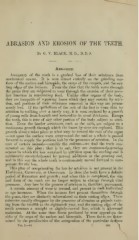Page 983 - My FlipBook
P. 983
ABRASION AND EROSION OF THE TEETH.
By G. V. BLACK, M. D., D. D. S.
Abrasion.
Abrasion of the teeth is a gradual loss of their substance from
mechanical causes. It is seen almost entirely on the grinding sur-
faces of the molars and bicuspids, the cusps of the cuspids, and the cut-
ting edges of the incisors. From the time that the teeth come through
the gums they are subjected to wear through the exercise of their pecu-
liar function in masticating food. Unlike other organs of the body,
they are incapable of repairing losses which they may sustain by attri-
tion, and jjortions of their substance removed in this way are perma-
nently lost. If the epithelium of the sole of the foot is worn thin by
attrition in walking over a sandy way, it is soon replaced by a groMth
of young cells from beneath and restored to its usual thickness. Except
the teeth, this is true of any other portion of the body subject to attri-
tion. Even the harder structures, such as the nails, are subject to a
continuous growth through which the losses by wear are replaced. This
growth always takes place at what may be termed the root of the organ
—not upon the surface worn away—and the nail as a whole is pushed
forward to supjjly the portions lost by the processes of attrition. In the
case of certain animals—notably the rodents—we find the teeth con-
structed on this plan ; that is to say, they are continuously-groicing
organs in which the loss sustained by attrition upon the icorking end is
continually counterbalanced by normal additions at the groiving end,
and in this way the Avhole tooth is continuously moved forward to com-
pensate for the loss.
This plan of compensating for loss by attrition is not present in the
Herbivora, Carnivora, or Omnivora. In these the teeth have a definite
period of formation and growth ; and when this is completed, the size
and form of the tooth are no longer subject to change through vital
processes. Any loss by the process of attrition is, therefore, permanent.
A certain amount of wear is normal, and present in each individual
as age increases. AVhen the incisors first present themselves through
the gums, they are distinctly tuberculated on their cutting edges. These
tubercles usually disappear by the processes of abrasion at periods vary-
ing from the twelfth to the eighteenth vear, and the cutting eNge of the
tooth assumes a straight or slightly-curved line, which it afterward
maintains. At the same time facets produced by wear appeaiKon the
sidcH of the cusps of the molars and bicuspids. These facets are (deter-
mined by the peculiarities of the antagonism of the particular deiVure
Vol. I.—63 993 1
\
1


